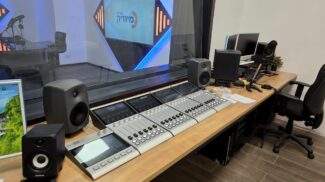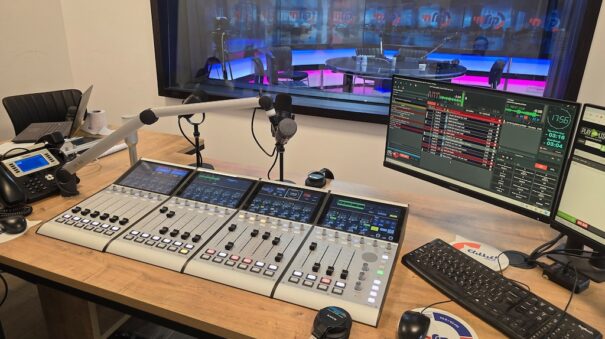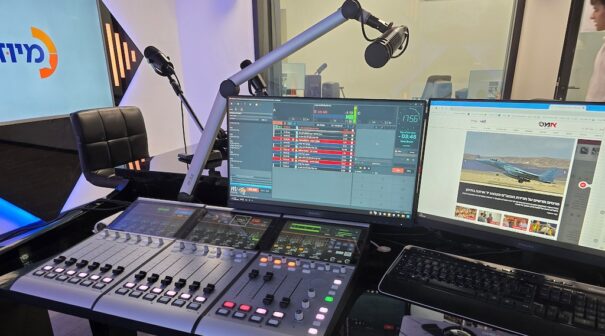Radio Kol-Chai opta por mezcladores de DHD Audio para su nueva sede central integrada en IP
La emisora con sede en Bnei Brak (al este de Tel Aviv, Israel), Radio Kol-Chai, ha elegido mezcladores de audio y núcleos de procesamiento de DHD como parte de su traslado a unos nuevos estudios de producción.
El sistema ha sido integrado por Broadcast Design, especialista en tecnología de audio con sede en Jerusalén. Incluye cuatro consolas DHD SX2 (dos con 16 faders y dos con 22 faders) y 11 paneles táctiles multifunción compactos TX2. Seis de los 11 mezcladores TX2 están asignados para uso del presentador y el productor en cada estudio, más dos para las cabinas de edición, dos para los supervisores y uno para la sala de control de TV. El procesamiento y la interconexión en red se realizan en núcleos DHD XC3.
Creada en 1996, Radio Kol-Chai produce dos canales de contenidos de audio y vídeo: Radio Kol-Chai FM y Radio Kol-Chai Music. La producción de Radio Kol-Chai FM incluye noticias, debates en directo, podcasts y música, así como información general y entretenimiento. Los canales se emiten seis días a la semana en la 93.0 FM para todo el centro de Israel y en la 92.8 FM para el distrito de Jerusalén. Los programas en directo y a la carta también están accesibles en www.93fm.co.il para una audiencia en línea mucho más amplia.
 Micha Blum, fundador y director general de Broadcast Design, comenta que «hemos integrado cuatro estudios. El estudio 4 se utilizará para la producción de vídeo y está equipado con un DHD SX2 de 22 fader. El Estudio 1 es para el canal general de Kol-Chai y el Estudio 2 para Kol Chai Music. El estudio 3 está destinado a la grabación y también puede funcionar como estudio de presentación de reserva. Cada estudio y cada cabina de locución pueden asignarse a cualquier canal. Una de las dos cabinas de edición también puede utilizarse para la presentación de noticias Top of the Hour».
Micha Blum, fundador y director general de Broadcast Design, comenta que «hemos integrado cuatro estudios. El estudio 4 se utilizará para la producción de vídeo y está equipado con un DHD SX2 de 22 fader. El Estudio 1 es para el canal general de Kol-Chai y el Estudio 2 para Kol Chai Music. El estudio 3 está destinado a la grabación y también puede funcionar como estudio de presentación de reserva. Cada estudio y cada cabina de locución pueden asignarse a cualquier canal. Una de las dos cabinas de edición también puede utilizarse para la presentación de noticias Top of the Hour».
«Radio Kol Chai emite muchos programas, boletines informativos y noticiarios cada hora desde otros lugares, como sus estudios de Jerusalén o desde un presentador en casa. Esto requiere una compleja gestión de talkback y códecs entre estos emplazamientos y el productor, editor y técnico de la sede de Bnei Brak. Se eligieron las consolas de audio DHD porque pueden utilizarse para gestionar todas las fuentes, la asignación de códecs, la monitorización, los talkbacks, las alarmas y la detección de silencios, además de sus funciones de mezcla de audio y producción, sin necesidad de equipos de terceros», añade.
«El sistema DHD también permite asignar fácilmente cualquiera de las consolas de mezcla de la sala de control a cualquier estudio. El estudio principal tiene una sala de control dedicada. Ésta puede asignarse para gestionar una emisión en directo, por ejemplo, mientras el estudio se utiliza para grabar una producción totalmente distinta. Configuramos un enrutamiento automático que gestiona los talkbacks bidireccionales entre presentador, productor y técnico de forma independiente a más de ocho códecs de audio. con una clara indicación de estado para evitar cualquier error».
«El traslado era el momento ideal para integrar una arquitectura de interconexión más avanzada, ya que aumenta la eficacia operativa y simplifica la futura ampliación del sistema. Las señales de cada estudio a la sala de control principal se envían a través de APC Audio de DHD, que permite la conexión de varios canales de audio mediante cables de red estándar punto a punto. El sistema se utilizará también para las producciones visuales de Radio Kol-Chai. También hemos impartido formación al equipo de operaciones y a los técnicos de apoyo de Radio Kol-Chai», señala Blum.
Controles intuitivos
«Las consolas de mezcla de audio DHD han funcionado muy eficazmente para nosotros durante los últimos 10 años», resume el director de proyectos de Radio Kol-Chai, Assaf Klein. «Son de construcción robusta y tienen controles intuitivos apoyados por visualizaciones en pantalla del estado y el nivel de señal. Esa combinación da a nuestros operadores la plena confianza que necesitan para trabajar en directo. Nuestro personal técnico aprecia la facilidad con la que se puede configurar cada mezclador DHD, además de la posibilidad de proporcionar ayuda conectada por IP a través de la aplicación web Assist de DHD si es necesario para una rutina de producción inusual o para un presentador invitado. Los ajustes del sistema, como el enrutamiento y la monitorización, pueden supervisarse en una pantalla TFT en la sala de control principal. Un operador autorizado puede acceder a la aplicación Assist desde cualquier lugar a través de un navegador web. Cada estudio tiene también una licencia de DHD Assist App que permite el soporte técnico en cualquier consola».
La consola SX2 de DHD se basa en un módulo central de cuatro faders. El módulo central da acceso a las entradas y salidas de audio más importantes. Incluye una entrada de micrófono y una salida de auriculares, y permite conectar directamente altavoces. Las consolas SX2 se amplían más allá de cuatro canales añadiendo uno o más módulos con seis faders motorizados cada uno. Esto permite integrar hasta 20 canales. Los módulos central y de faders incorporan cada uno una pantalla multitáctil de 10,1 pulgadas que muestra los parámetros de configuración y funcionamiento relevantes. Las funciones de SX2 pueden ampliarse simplemente añadiendo códigos de licencia opcionales al núcleo DSP, lo que permite añadir faders, buses y clean-feeds adicionales. También admite funciones como la medición de sonoridad y el talkback con otros mezcladores DHD.
La TX2 de DHD es una consola de mezclas multitáctil con una interfaz de control intuitiva para el uso diario en mesas de redacción, como paneles de co-presentación, en salas de edición y en vehículos SNG. Su diseño plano de sobremesa incluye una pantalla multitáctil de 10,1 pulgadas, dos potenciómetros asignables y seis botones hardware multicolor silenciosos, que permiten realizar mezclas de audio profesionales en un espacio reducido. Los conectores más importantes están disponibles directamente en el aparato para entrevistas telefónicas o doblaje. Un único cable de red conecta el TX2 a un procesador central o concentrador. El cable transporta todas las señales de audio y control, además de la alimentación, hasta 100 m del núcleo. El TX2 es una forma muy útil y sencilla de ampliar cualquier sistema DHD. Se puede utilizar con núcleos XC3 o XD3 como dispositivo independiente o como parte de un sistema de mezcla más grande y no requiere un PC para su funcionamiento.
Los núcleos de procesamiento de señales digitales de DHD constituyen el corazón de todo sistema DHD, ya que conectan las superficies de control, realizan el enrutamiento de entrada/salida y la interconexión con el mundo exterior. Las señales de audio IP y el control remoto de dispositivos conectados por IP pueden integrarse estrechamente.
También admite flujos de trabajo automatizados y virtualización de productos. El núcleo IP XC3, que ocupa sólo 1U de espacio de rack, está diseñado para su uso en estudios de emisión. Consta de dos módulos DSP de doble núcleo que se combinan en 1U. Admiten conjuntamente hasta 48 faders estéreo, 72 buses estéreo y 16 canales de audio IP AES67. Se pueden añadir módulos de expansión IPx para acomodar 128 canales de entrada/salida de audio IP AES67/Ravenna más hasta 512 canales Dante. Un módulo complementario, el concentrador XC3, permite interconectar fácilmente varios módulos DHD IPx, superficies de control y módulos de E/S.
¿Te gustó este artículo?
Suscríbete a nuestro NEWSLETTER y no te perderás nada.




